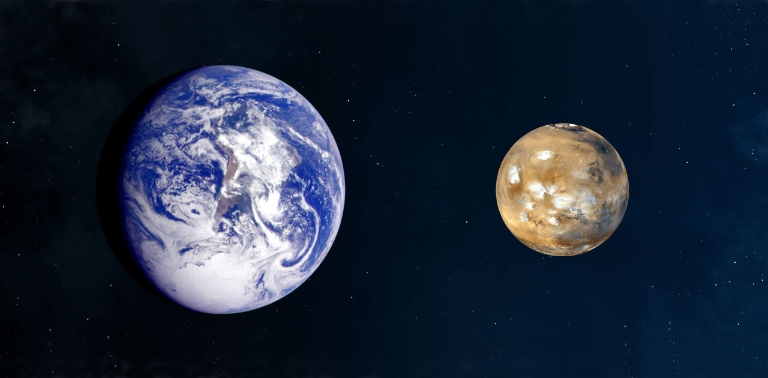
Earth and Mars, size comparison. NASA image.
Brought to you by WBIW News and Network Indiana
Last updated on Monday, November 5, 2018
(BLOOMINGTON) - Mars will be the only bright planet high in the evening sky during November. The Red Planet will be highest in the south around 8 p.m. local daylight saving time Nov. 1 and about 6 p.m. standard time Nov. 30.
It will fade and shrink as the month passes, setting near midnight standard time all month. This will be the last opportunity to see surface features of the red-orange planet on clear nights with a small to a medium-size telescope.
Jupiter will set only about an hour after the sun for viewers around 40 degrees north latitude as November begins. A week later it will be lost in the solar glare.
Mercury will be 8 degrees to the upper left (south) of Jupiter on Nov. 6, but it will disappear into the sun's afterglow after that. On Nov. 27, the two planets will be less than 1 degree apart but only about 1 degree from the sun.

Earth and Mars, size comparison. NASA image.
Saturn will set more than three hours after the sun at the start of November and an hour earlier by month's end. The ringed planet will glow bright yellow in the southwest near the Teapot formation of the constellation Sagittarius. Its largest moon, Titan, will be visible with any telescope.
Venus will be a lovely sight above the southeastern horizon before dawn during November. For those watching around 40 degrees north latitude, this "morning star" will appear about a half-hour before the sun on Nov. 1 but more than three hours before sunrise Nov. 30. The brilliant white planet will be visible with the unaided eye well after sunrise, and it will be a fascinating sight in binoculars and telescopes. Venus will be less than 2 degrees from the bright white star Spica on the mornings of Nov. 12 to 17.
Meteor shower
The annual Leonid meteor shower will peak the night of Nov. 17-18. The moon will set before 2 a.m. local time, leaving more than three hours of unhampered viewing before the start of morning twilight. The maximum rate in a clear sky will be about 15 meteors per hour.
The shower's radiant, the point from which the meteors appear to come, will be in the constellation Leo. The bright star Regulus is part of Leo and can serve as a marker for the radiant. The farther sickle-shaped Leo climbs above the southeastern horizon, the more meteors there will be all over the sky.
The Leonid meteors are caused by streams of dust particles from Comet Tempel-Tuttle. They strike Earth's atmosphere at 44 miles per second, the fastest of any meteors, so they produce more fireballs than most showers. More information about meteor showers is available from the American Meteor Society.
Moon phases
The moon will be new on Nov. 7, at first quarter on Nov. 15, full on Nov. 23 and at third quarter on Nov. 30.
1340 AM WBIW welcomes comments and suggestions by calling 812.277.1340 during normal business hours or by email at comments@wbiw.com
© Ad-Venture Media, Inc. All Rights Reserved.